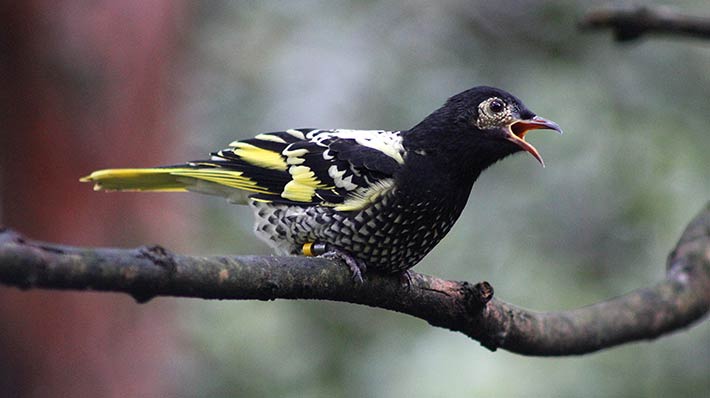Copy cats
The Regent Honeyeater was once seen overhead in flocks of hundreds across south-eastern mainland Australia from eastern Queensland to South Australia. However these days these birds are elusive and difficult to track. Their distribution is patchy however they can fly long distances to follow the flowering of favoured plant species. During the winter period, they often exhibit an unusual behaviour where isolated individuals associate with and then often mimic the calls of wattlebirds and friarbirds. Although many birds display the behaviour of vocal mimicry, no other bird species is known to mimic close relatives in this way.
Home sweet home
Regent Honeyeaters are very clever nest builders! Their nests are constructed of strips of eucalypt bark, dried grasses and other plant materials. The bark strips form a thick, walled cup with cobwebs binding it together and fine dried grasses lining the nest. Their eggs are an unusual red-buff colour and are speckled with small purple-red and violet-grey markings. While the female incubates the eggs the loyal male always close in nearby trees. He even helps the female with the feeding of the young once they hatch!
Singing for your supper
The Regent Honeyeater loves the flowers of four eucalypt species for its nectar supply and will also eat fruit, insects, manna gum and lerps which are a small bug that lives on gum leaves. They feed quickly and aggressively in the outer foliage then fly swiftly from tree to tree collecting nectar and catching insects in flight. If you listen closely, they make a beautiful quiet, flute-like, metallic ringing call. When several birds congregate in a feeding tree, they squabble among themselves, bobbing and stretching their heads.
Ecological engineers
The Regent Honeyeater has become a 'flagship species' for conservation in the threatened box-ironbark forests of Victoria and NSW on which it depends. These stunning birds help maintain healthy populations of our iconic eucalyptus trees through pollination, providing important food and habitat for many other native animals. The decline of the Regent Honeyeater has had a huge impact on the greater ecosystem because these birds are major contributors to the pollination of native plant species. The plight of this species in the wild has drawn attention to the importance of protecting our beautiful natural forest landscapes. Efforts to save the Regent Honeyeater will also help to conserve remnant communities of other threatened or near threatened animals and plants, including the Swift Parrot, Superb Parrot, Brush-tailed Phascogale, Squirrel Glider and Painted Honeyeater.

Come and meet us
The Regent Honeyeater can be spotted at the Blue Mountains Bushwalk, Taronga Zoo Sydney, and in the Wildlife Hospital Aviary at Taronga Western Plains Zoo, Dubbo.